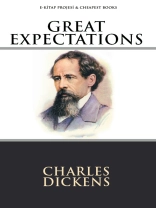Great Expectations is Charles Dickens’s thirteenth novel. It is his second novel, after David Copperfield, to be fully narrated in the first person. Great Expectations is abildungsroman, or a coming-of-age novel, and it is a classic work of Victorian literature. It depicts the growth and personal development of an orphan named Pip. The novel was first published in serial form in Dickens’ weekly periodical All the Year Round, from 1 December 1860 to August 1861. In October 1861, Chapman and Hall published the novel in three volumes.
Great Expectations was to be twice as long, but constraints imposed by the management of All the Year Round limited the novel’s length. Collected and dense, with a conciseness unusual for Dickens, the novel represents Dickens’ peak and maturity as an author. According to G. K. Chesterton, Dickens penned Great Expectations in ‘the afternoon of [his] life and fame.’ It was the penultimate novel Dickens completed, preceding Our Mutual Friend.
It is set among the marshes of Kent and in London in the early to mid-1800s. From the outset, the reader is ‘treated’ by the terrifying encounter between Pip, the protagonist, and the escaped convict, Abel Magwitch. Great Expectations is a graphic book, full of extreme imagery, poverty, prison ships, ‘the hulks, ‘ barriers and chains, and fights to the death. It therefore combines intrigue and unexpected twists of autobiographical detail in different tones. Regardless of its narrative technique, the novel reflects the events of the time, Dickens’ concerns, and the relationship between society and man.
The novel has received mixed reviews from critics: Thomas Carlyle speaks of ‘All that Pip’s nonsense, ‘ while George Bernard Shaw praised the novel as ‘All of one piece and Consistently truthfull.’ Dickens felt Great Expectations was his best work, calling it ‘a very fine idea, ‘ and was very sensitive to compliments from his friends: ‘Bulwer, who has been, as I think you know, extraordinarily taken by the book.’
ABOUT AUTHOR:
Charles John Huffam Dickens (1812 – 1870) was an English writer and social critic. He created some of the world’s most memorable fictional characters and is generally regarded as the greatest novelist of the Victorian period. During his life, his works enjoyed unprecedented fame, and by the twentieth century his literary genius was broadly acknowledged by critics and scholars. His novels and short stories continue to be widely popular.
Born in Portsmouth, England, Dickens was forced to leave school to work in a factory when his father was thrown into debtors’ prison. Although he had little formal education, his early impoverishment drove him to succeed. Over his career he edited a weekly journal for 20 years, wrote 15 novels, 5 novellas and hundreds of short stories and non-fiction articles, lectured and performed extensively, was an indefatigable letter writer, and campaigned vigorously for children’s rights, education, and other social reforms.
Dickens sprang to fame with the 1836 serial publication of The Pickwick Papers. Within a few years he had become an international literary celebrity, famous for his humour, satire, and keen observation of character and society. His novels, most published in monthly or weekly instalments, pioneered the serial publication of narrative fiction, which became the dominant Victorian mode for novel publication. The instalment format allowed Dickens to evaluate his audience’s reaction, and he often modified his plot and character development based on such feedback. For example, when his wife’s chiropodistexpressed distress at the way Miss Mowcher in David Copperfield seemed to reflect her disabilities, Dickens went on to improve the character with positive features. Fagin in Oliver Twist apparently mirrors the famous fence Ikey Solomon; His caricature of Leigh Hunt in the figure of Mr Skimpole in Bleak House was likewise toned down on advice from some of his friends, as they read episodes. In the same novel, both Lawrence Boythorne and Mooney the beadle are drawn from real life – Boythorne from Walter Savage Landorand Mooney from ‘Looney’, a beadle at Salisbury Square. His plots were carefully constructed, and Dickens often wove in elements from topical events into his narratives. Masses of the illiterate poor chipped in ha’pennies to have each new monthly episode read to them, opening up and inspiring a new class of readers.












